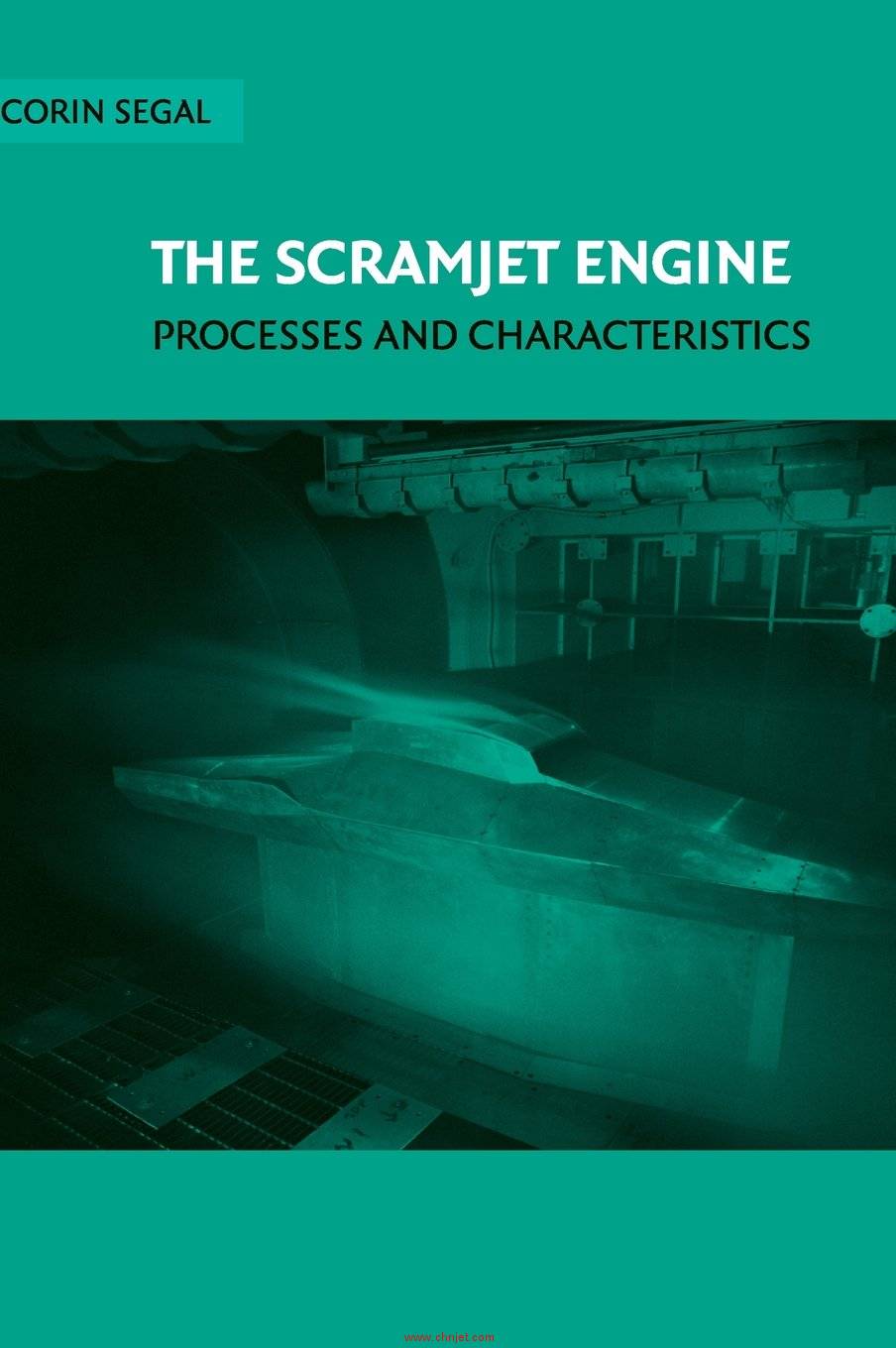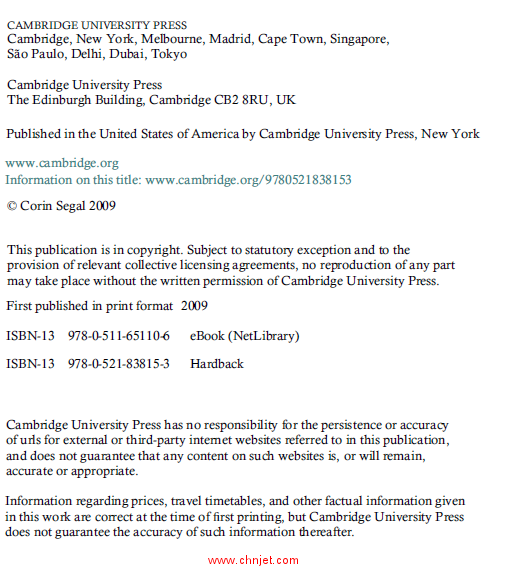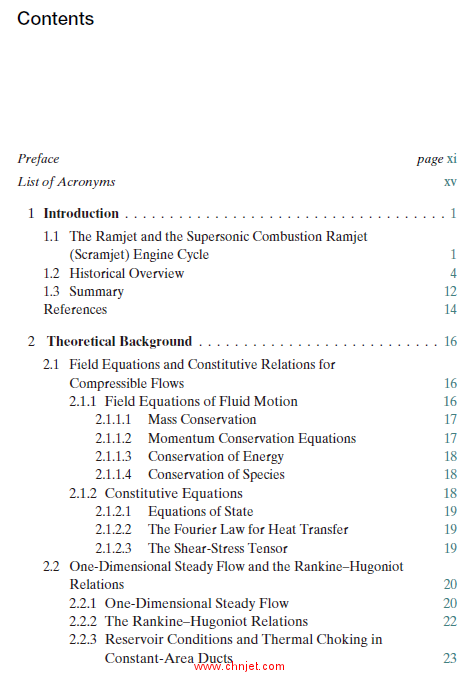马上注册,结交更多好友,享用更多功能,让你轻松玩转社区。
您需要 登录 才可以下载或查看,没有账号?立即注册


x
本帖最后由 请叫我雷锋 于 2023-1-17 11:32 编辑
《The Scramjet Engine: Processes and Characteristics》
超燃冲压发动机:过程和特点
作者:Corin Segal
University of Florida
出版社:Cambridge
出版时间:2009年
《The Scramjet Engine: Processes and Characteristics》

《The Scramjet Engine: Processes and Characteristics》

《The Scramjet Engine: Processes and Characteristics》

《The Scramjet Engine: Processes and Characteristics》

目录
Preface page xi
List of Acronyms xv
1 Introduction . . . . . . . . . . . . . . . . . . . . . . . . . . . . . . . . . . . . 1
1.1 The Ramjet and the Supersonic Combustion Ramjet
(Scramjet) Engine Cycle 1
1.2 Historical Overview 4
1.3 Summary 12
References 14
2 Theoretical Background . . . . . . . . . . . . . . . . . . . . . . . . . . . 16
2.1 Field Equations and Constitutive Relations for
Compressible Flows 16
2.1.1 Field Equations of Fluid Motion 16
2.1.1.1 Mass Conservation 17
2.1.1.2 Momentum Conservation Equations 17
2.1.1.3 Conservation of Energy 18
2.1.1.4 Conservation of Species 18
2.1.2 Constitutive Equations 18
2.1.2.1 Equations of State 19
2.1.2.2 The Fourier Law for Heat Transfer 19
2.1.2.3 The Shear-Stress Tensor 19
2.2 One-Dimensional Steady Flow and the Rankine–Hugoniot
Relations 20
2.2.1 One-Dimensional Steady Flow 20
2.2.2 The Rankine–Hugoniot Relations 22
2.2.3 Reservoir Conditions and Thermal Choking in
Constant-Area Ducts 23
v
vi Contents
2.3 Chemical Reactions and Equilibrium 25
2.3.1 Thermodynamic Relations and the Gibbs Function 25
2.3.2 Chemical Equilibrium 26
2.3.3 The Law of Mass Action and Reaction-Rate
Constants 28
2.3.4 Air Equilibrium Composition 30
2.4 Nonequilibrium Considerations 32
References 33
3 High-Temperature Gas Dynamics and Hypersonic Effects . . . . . 35
3.1 Introduction 35
3.2 Real-Gas Equation of State 36
3.3 Elements of Kinetic Theory 37
3.3.1 Pressure, Energy, and the Equation of State 37
3.3.2 Mean Free Path 40
3.3.3 Maxwellian Distribution – Velocity Distribution
Function 42
3.3.4 Transport Coefficients 44
3.4 Elements of Statistical Thermodynamics 46
3.4.1 Microscopic Description of Gases 47
3.4.1.1 Modes of Energy 47
3.4.1.2 Quantum Energy Levels and Degeneracies 49
3.4.1.3 Enumeration of Microstates and the
Macrostate 51
3.4.2 Counting the Number of Microstates for a Given
Macrostate 51
3.4.3 The Most Probable State 53
3.4.4 The Boltzmann Distribution 53
3.4.5 Thermodynamic Properties in Terms of
the Partition Function 54
3.4.6 Evaluation of the Partition Function 55
3.4.7 Evaluation of Thermodynamic Properties 57
3.5 Hypersonic Flow 59
References 61
4 Cycle Analyses and Energy Management . . . . . . . . . . . . . . . . . 62
4.1 Introduction 62
4.2 Ideal Scramjet Cycle 64
4.3 Trajectory and Loads 68
4.4 Performance Analysis 70
4.5 Combined Cycles 72
4.5.1 The Turbine-Based Combined Cycle – TBCC 73
Contents vii
4.5.2 The Rocket-Based Combined Cycle – RBCC 75
4.5.2.1 RBCC Systems’ Mode of Operation 76
4.5.2.2 Combined-Cycle Propulsion Technical Issues 78
4.5.2.3 Mode-Specific RBCC Technical Issues 79
References 82
5 Inlets and Nozzles . . . . . . . . . . . . . . . . . . . . . . . . . . . . . . . . 87
5.1 Inlets 87
5.1.1 Introduction 87
5.1.2 Compression Process Efficiency and Energetic
Balance 90
5.1.2.1 Pressure Recovery and Kinetic Energy
Efficiency 90
5.1.2.2 The Pressure Coefficient KWP 93
5.1.2.3 Inlet Performance – Compression and
Contraction Ratio Effects 95
5.1.3 Flow Interactions and Inlet Design Considerations 98
5.1.3.1 Inlet Starting 98
5.1.3.2 Viscous Interactions 100
5.1.3.3 Shock–Boundary-Layer Interactions 103
5.1.4 Advanced Concepts for Inlet-Flow Control 106
5.1.4.1 Intake Air Energy Management 106
5.1.4.2 Flow Deceleration Using a Magnetic Field 107
5.1.4.3 Flow Control Using Fuel Injection 114
5.1.5 Summary 121
5.2 Nozzles 122
References 124
6 Supersonic Combustion Processes . . . . . . . . . . . . . . . . . . . . . 127
6.1 Introduction 127
6.2 Time Scales 128
6.3 Fuel–Air Mixing 130
6.3.1 Parallel, Unbounded, Compressible Flows 131
6.3.1.1 The Definition of the Convective Mach
Number 133
6.3.1.2 Two-Dimensional Shear-Layer Growth –
Velocity and Density Dependence 135
6.3.1.3 Compressibility Effects on Shear-Layer
Growth 136
6.3.1.4 Effects of Heat Release on the Shear Layer 137
6.3.1.5 Mixing Within the Shear Layer 138
6.3.2 Mixing of Angled or Transverse Flows 139
viii Contents
6.3.3 Degree of Mixing and Mixing Efficiency 148
6.3.4 Mixing Enhancement 151
6.4 Chemical Kinetics – Reaction Mechanisms 157
6.4.1 Hydrogen–Air Reaction Mechanisms 158
6.4.1.1 Reduced Mechanisms for Hydrogen–Air
Combustion 163
6.4.2 Reaction Mechanisms for Hydrocarbons 165
6.4.3 Summary 170
6.5 Flame Stability 171
6.5.1 Recirculation-Region Flow Field 172
6.5.2 Recirculation-Region Temperature 174
6.5.3 Local Equivalence Ratio Analysis 176
6.5.4 Recirculation-Region Composition Analysis 177
6.5.5 Stability Parameter Formulations 179
6.5.6 Summary 182
6.6 Combustion Chamber Design and Heat-Release Efficiency 182
6.6.1 Isolator 183
6.6.2 Combustion Chamber Design and Performance 187
6.6.2.1 General Chamber Design Parameters 187
6.6.2.2 Pressure Rise and Combustion Efficiency 189
6.7 Scaling Factors 198
6.8 Fuel Management 201
6.8.1 Fuels as Vehicle and Engine Component
Coolant Agents 201
6.8.2 Thermal versus Catalytic Decomposition 204
6.8.3 Fuel Management 206
References 207
7 Testing Methods and Wind Tunnels . . . . . . . . . . . . . . . . . . . 215
7.1 Introduction 215
7.2 Hypersonic Flight Domain 215
7.3 Blowdown Facilities 217
7.3.1 Combustion-Heated Wind Tunnels 217
7.3.2 Electrically Heated Wind Tunnels 219
7.3.3 Arc-Heated Facilities 221
7.4 Short-Duration, Pulsed-Flow Wind Tunnels 222
7.4.1 Shock Tunnels 222
7.4.2 Free-Piston Shock Tubes 224
7.4.3 Expansion Tubes 225
7.5 Summary 227
References 227
Contents ix
8 Computational Fluid Dynamic Methods and Solutions
for High-Speed Reacting Flows . . . . . . . . . . . . . . . . . . . . . . 229
8.1 Introduction 229
8.2 Conservation Equations and Flow Physics Captured
in These Equations 230
8.2.1 Field and Constitutive Equations 230
8.2.2 Molecular Transport of Species and Heat 231
8.3 Turbulent Reacting Flow – Length Scales 234
8.4 Computational Approaches for Turbulent, Chemically
Reacting Flows 236
8.4.1 Direct Numerical Simulation 237
8.4.2 Reynolds-Averaged Navier–Stokes Simulation 238
8.4.3 Turbulence Models 239
8.4.4 Large-Eddy Simulation (LES) 240
8.5 Scramjet-Flow Computational Results 241
8.5.1 Steady-State Nonreacting Flows 242
8.5.2 Chemically Reacting Flows 244
8.6 Summary 248
References 249
Index 251
专业书籍
下载地址:(回复后可见)
城通网盘:下载,密码:554827
| ![]()
![]()